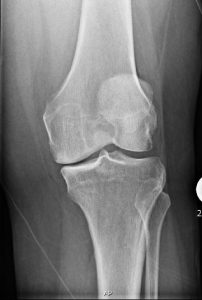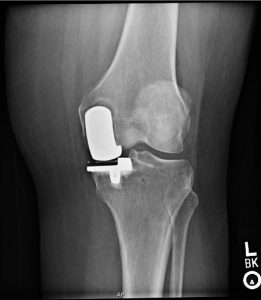Partial Knee Replacement

Before Partial Knee Replacement

After Partial Knee Replacement
Background
There is much debate as to whether a person should go with a partial knee replacement versus a total knee replacement, considerations to remember are definitely the age at which you are going through with the surgery, the activity level at which you operate, and the level of arthritis you are experiencing. There are advantages and disadvantages to choosing the partial knee versus the total knee replacement, the biggest being that the partial knee allows the knee to feel more normal compared to it feeling so robotic in a total knee. There are 3 types of partial knee surgeries you could accept there is the unicompartmental knee system, the bicompartmental knee system and finally the tricompartmental knee system. The partial knee system is meant to be able to save the ACL and the PCL, this keeps the knee from feeling so robotic. The entire knee is not going to be covered by metal, the metal will encase the bone with plastic spacers in between. The plastic is cemented to the bone with bone cement to ensure that the new knee does not fall away.
Treatment
Exercise/activity:
Before your surgery we suggest that if you are healthy enough, you should begin or continue with an exercise program. This can be initiated through a physical therapy clinic or through a home-exercise program. Walking daily is an easy way to get some physical activity prior to surgery. The more you are able to do before surgery, the better off you will be following surgery. A therapist will be able to perform a functional assessment and identify any preoperative impairments.
Scheduling:
The surgical facility will contact you and review your medical history, medications, and allergies 3-5 days prior to surgery. They will confirm your arrival time and make sure that you understand where to go on your day of surgery.
Infection prevention:
You may or may not be given a preoperative surgical soap to use over the 3 day period before surgery. If you have a history of severe infection or MRSA please make sure the surgeon or physician assistant is aware of this prior to surgery as it may be necessary to take additional steps to help prevent a postoperative infection.
Eating and Drinking:
It is imperative that you DO NOT EAT OR DRINK ANYTHING AFTER MIDNIGHT PRIOR TO YOUR SURGERY. Even if you have a case scheduled later in the day, sometimes our surgical teams will run ahead of schedule and you will be called to come to the surgical facility early, if you have eaten since midnight this will delay your surgical starting time by up to 8 hours after the time you last ate or drank.
Day of Surgery:
Arrival:
You will need to arrive at the facility at least 90 minutes prior to your scheduled procedure. Sometimes you will require additional blood and urine testing prior to your surgery. Leave all valuables at home and wear comfortable clothes and bring comfortable clothing for after surgery.
Preparation for surgery:
You will be asked to change into a surgical or hospital gown and the nursing staff will start an IV and begin giving you fluids through the IV. Staff will ask you many questions about your health, your medications, and your allergies. It is important that you answer their questions truthfully and as completely as you can. This is important for your health and safety during and after surgery. You may be asked to clean the surgical site once more with a skin cleansing wipe and mark the area with a surgical marker.
Anesthesia:
You will meet and visit with your anesthesia provider prior to your surgery. They will discuss your medical history, any anesthesia concerns, and different anesthesia options including regional blocks, spinal anesthesia, and general anesthesia.
Surgical Consent:
You will meet with your surgeon one more time before surgery. This is an opportunity to ask any final questions, clarify the procedure, and to discuss the risks and benefits of surgery one more time before getting started. The surgeon will sign your operative site. If you have questions or concerns please talk to your surgeon about these at this time.
After Surgery:
Recovery:
You will be taken to the recovery room after surgery. Your doctor will speak to your family and explain how the procedure went. You will stay in the recovery room for approximately 1 hour and then transferred to your room. During this time and throughout your hospital stay you need to communicate with your nurse and let them know if you are having pain or other problems. You need to let them know if the medications they are using are working to adequately control your pain. You need to let someone know immediately if you are experiencing nausea, chest pain, shortness of breath, or any other issues.
Antibiotics/infection prevention:
You will receive IV antibiotics for 24 hours after your surgery. Usually, antibiotics are not required after that 24 hour period. Urinary catheters (if placed) will be removed on postoperative day 1 after your surgery to prevent a bladder or other urinary tract infection. Drains (if placed) will likely be removed on postoperative day 1 and your dressing will be changed on postoperative day 2 or sooner if necessary.
Blood clot prevention:
During your hospital stay you will be given injections to prevent blood clots. At discharge you will be instructed to take 325mg of aspirin twice a day for a period of time (3-6 weeks) to help prevent blood clot formation. If you have a history of blood clots, pulmonary embolism (blood clot in the lungs), or other blood clotting disorder you may need to take a prescription blood thinner (such as Coumadin, Xarelto, or similar medication) and you may require weekly monitoring of your blood.
Physical therapy:
Physical therapy will begin as early as the day of your surgery but most often on postoperative day 1. This is where the real work of your recovery begins. You will be instructed on the use of crutches, or a walker.. You will be instructed on how much weight you can place on your operative limb.
You will have to achieve certain goals prior to being discharged from the hospital. This is to ensure that your are safe and have the strength to return home.
You must be able to:
Stand at the edge of the bed
Walk 100 ft in the hallway
Safely get to and use the bathroom
Transfer out of the bed to a chair or to the bathroom
Ascend and descend stairs safely
Going Home:
Pain Management:
You will be given pain medication prescriptions at the time of discharge. These may include narcotic medications.
Physical Therapy:
You will need to follow up with a physical therapy office after your discharge from the hospital to continue your rehabilitation. It is imperative that you regain your full knee extension. Full extension is required for your quadriceps (your thigh muscle) to fully function so that you can walk appropriately.
Postoperative activity:
It is important to remain active after surgery. You should be getting up several times during the day to walk and exercise. When at rest you should be working on achieving full extension of your knee. Do not put pillows behind your knee while you are sitting or lying in bed, this will help you to get full extension. We recommend continuing to use ice to help prevent pain and swelling. You may require a front wheeled walker or other assistive device for the first 10 days and then transition to a cane or walking stick.
Follow up:
You will return to the office in 10-14 days for staple/suture removal and to evaluate your progress with rehabilitation. You might have x-rays taken at that time to evaluate the placement of your hardware. You will have regular x-rays over the next several months to keep track of how your knee is healing.
The staff at Big Horn Basin Bone and Joint will be available if any issues or concerns arise during the course of your care. All questions are welcomed and we will do our best to address any issues or questions in a timely manner. We highly recommend signing up for the portal system through our electronic medical record. This is a safe-secure and efficient way to communicate with your Doctor, PA, and our staff. Our number one concern is helping you to recover and regain your quality-of-life.
